2. 江苏省环境保护空气复合污染物监测重点实验室, 苏州 215000;
3. 苏州常卫环保科技有限公司, 苏州 215000;
4. 中国科学院生态环境研究中心, 北京 100085
2. Key Laboratory of Atmospheric Combined Pollution Monitoring, Environmental Protection Department of Jiangsu Province, Suzhou 215000, China;
3. Suzhou Changwei Environmental Protection Technology Co., Ltd., Suzhou 215000, China;
4. Research Center for Eco-Environmental Sciences, Chinese Academy of Sciences, Beijing 100085, China
汞是一种持久性的有毒金属污染物, 对人类健康和生态环境造成极大危害[1, 2].环境中汞的来源分为自然源和人为源, 自然源主要来自火山、森林火灾、地热喷口、土壤和水面的蒸发; 而人为源主要来自煤炭燃烧、有色金属生产、水泥生产和固体废物焚烧等[3, 4].据推测, 2010年, 全球约有6 500 t汞通过自然源和人为源排放到大气中, 东亚和东南亚贡献了全球约40%的人为汞排放[5].目前, 随着我国经济快速增长和工业迅速发展, 汞作为能源消费的重要污染排放物, 我国每年人为大气汞排放量约为500~800 t, 占全球人为汞排放总量的30%左右[6, 7], 汞污染已经成为我国环境污染问题之一, 研究大气汞分布特征和来源有助于从源头控制人为源汞污染的排放, 实现汞污染排放的有效控制.
人为源排放的汞会通过大气进行长距离的传输, 在沉降到地面之前经历各种物理和化学转变, 再到地表水和土壤等环境中.因而大气汞是汞污染的主要迁移转化过程, 大气汞具有3种形态:气态元素汞(gaseous element mercury, GEM或Hg0)、气态氧化汞(gaseous oxidized mercury, GOM或Hg2+)和颗粒汞(particulate bound mercury, PBM或Hgp)[3, 4].GEM是大气中最稳定的汞, 占90%以上, 在大气中的停留时间0.5~2 a, 可以长距离迁移[6, 7].GEM在云水中与O3、OH-和H2 O2等氧化剂反应生成GOM, 或在气相中直接被O3氧化; 反过来, GOM被SO2(g)或SO32-(aq)还原转化为GEM[8].GEM和GOM结合或吸附在颗粒物上, 形成PBM[8].GOM和PBM具有较高的表面反应活性和水溶性, 干湿沉降速率较快, 它们在大气中的停留时间较短, 仅有几小时到几周不等[8, 9].
近20年, 加拿大、美国和欧洲国家通过一系列监测网络对本地区和全球范围内大气汞进行了监测[10, 11].目前, 全球大气中汞的本底浓度的普遍共识是:北半球约为1.50~1.70 ng ·m-3, 南半球约为1.10~1.30 ng ·m-3[12, 13].由于受大气汞长距离迁移等综合作用, 在北极和小部分南极地区监测到GEM的年均浓度分别为1.60 ng ·m-3和1.00 ng ·m-3[13]. 2012~2017年南美洲南部的火山带内的GEM平均浓度为(0.86±0.16)ng ·m-3, 最高浓度出现在春天[(0.95±0.13)ng ·m-3], 最低浓度出现在秋天[(0.80±0.15)ng ·m-3], 风向、气温和相对湿度影响GEM浓度的动态监测数据[14].
近年来, 我国多地也开展大气中汞的研究工作, 2015~2016年, Zhang等[15]对北京大气中汞进行了监测, GEM、GOM和PBM的平均浓度分别为(4.70±3.53)ng ·m-3、(18.47±22.27)pg ·m-3和(85.18±95.34)pg ·m-3, 研究发现随着PM2.5浓度的升高, PBM浓度升高, GOM浓度逐渐降低.Sheu等[16]在中国台湾北部的郊区站点开展了大气汞监测, 研究发现受局部人为源影响, 35%的监测日中, 大气汞浓度升高发生在午夜和清晨, 通过反向轨迹研究认为我国东部地区雾-霾期间的汞排放可能是中国台湾北部郊区大气汞浓度增强的原因之一.已开展的区域性大气汞污染研究表明, 区域大气汞污染的变化规律差异性较大, 针对区域大气汞的污染特征仍然有深入研究的价值.
江苏苏州地处长三角重要的地理位置, 经济发达、城市化进程迅速、能源消耗巨大、季节季风强烈, 具有独特的自然和人为环境.本研究针对苏州市大气汞污染特征及来源, 在苏州市区设立监测点, 采用Tekran监测系统对大气中GEM、GOM和PBM进行连续监测, 表征汞的种类, 分析汞与共同污染物和气象条件的关系, 利用潜在源分析法给出苏州市大气汞的浓度, 揭示影响大气汞行为的主要因素和汞污染的潜在来源, 并探讨其浓度变化规律和对其它大气污染物的依赖关系.
1 材料与方法 1.1 监测点位和时间监测点位设置在苏州市环境科学研究所办公大楼四楼楼顶(120.627 5°E, 31.286 4°N), 采样头距离地面高度约为15 m.采样点周围主要为居民区, 1 km范围内无工业生产污染物排放, 往北直线距离500 m为苏州市护城河, 往南直线距离370 m为苏州市南环高架路, 监测点30 km范围内的汞污染排放点源详见图 1.
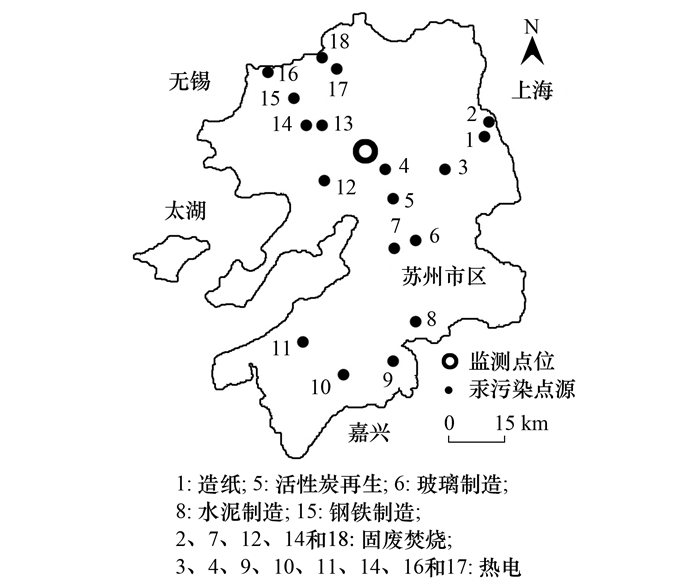
|
图 1 监测点位及其周边汞排放源分布示意 Fig. 1 Location of the sampling site and distribution of industrial Hg emitters |
汞测量工作于2018年1月1日至2018年12月31日开展.
1.2 监测仪器和方法本研究使用Tekran分析仪(2537B/1130/1135, Tekran公司, 美国)对GEM、GOM和PBM进行测量.系统自动采样分析过程分成两个周期:第一个周期, 采样气体经过采样管路, 采样气体中GEM直接进入Tekran 2537B完成GEM分析, 而GOM和PBM则分别富集在Tekran 1130和Tekran 1135的采样管路中; 第二个周期, 大流量载气经过采样管路, 同时系统依次加热Tekran 1130(800℃)和Tekran 1135(500℃)中的采样管路, 将富集在采样管路中的GOM和PBM先后解析成GEM并进入Tekran 2537B中完成定量分析.整个大气汞监测系统中的两个独立过程耦合进行, 完成大气中单质汞及其分类化合物的实时连续监测, 完成整个采样分析周期需要2 h.
1.3 其它监测指标和气象数据分别采用Thermo Fisher 49i、43i、48Itle、43i和5030(赛默飞世尔科技公司, 美国)在监测点同时监测O3、SO2、CO、NOx和PM2.5等大气污染物.采用R.M.Young气象仪(R.M.Young公司, 美国)EMM-03/04在监测点同时监测气温、湿度、太阳总辐射、风速、风向等气象参数.对仪器进行了定期的测试和校准.
1.4 质量控制和质量保证Tekran 2537B仪器日常使用内部GEM渗透源进行自动校准, 必要时进行外部手动校准.对每个纯金药筒分别进行两点校准, 包括零点校准和量程校准.用人工注入的方法来评估这些使用标准饱和汞蒸气的自动校准.人工注射与自动校准的相对偏差小于2%, GEM的检出限为0.1 ng ·m-3; 检出率在85% ~110%之间, 平均为96.3%.玻璃管涂上KCl溶液(45 g KCl: 250 g H2 O), 每两周更换一次.
收集到的数据是每2 h一次, 每天自动校准进行1 h.例如, 采样时间第1 d是00:00、02:00、04:00、06:00、08:00、10:00、12:00、14:00、16:00、18:00、20:00和22:00, 那么自动化日常校准进行1 h和采样时间第2 d是01:00、03:00、05:00、07:00、09:00、11:00、13:00、15:00、17:00、19:00、21:00和23:00.
1.5 浓度权重轨迹分析方法使用浓度权重轨迹分析法(CWT)进行大气汞的来源分析.该方法将研究区域划分为0.5°×0.5°的网格, 每一个网格内计算权重浓度, 其浓度计算公式如下:

|
(1) |
式中, cij是网格(i, j)的权重浓度; cl为l轨迹对应的浓度; τijl为轨迹l在网格(i, j)中停留的时长; M是网格(i, j)中轨迹节点数[17, 18].
2 结果与讨论 2.1 大气中汞的浓度表 1为苏州市大气中GEM、GOM和PBM浓度监测统计结果.苏州市大气中GEM、GOM和PBM浓度分别在0~53.3 ng ·m-3、0~256 pg ·m-3和0~5 208 pg ·m-3, 年均浓度分别为(2.57±2.09)ng ·m-3、(5.27±15.7)pg ·m-3和(16.0±157)pg ·m-3.GEM约占总汞的99.2%, 远超GOM(0.2%)和PBM(0.6%), 并高于上海(97%)和厦门(93.7%)[6].总体而言, 苏州大气中3种汞含量均高于北半球的本底浓度(GEM:1.5~1.7 ng ·m-3; GOM和PBM:1~5 pg ·m-3)[12, 13].
|
|
表 1 GEM、GOM和PBM浓度统计分析 Table 1 Statistical summary for the concentrations of GEM, GOM, and PBM |
表 2给出了各地区大气汞浓度, 并按照城市、郊区、农村和偏远(或背景)分为4类进行大气汞浓度的比较.从中可以看出, 上海、厦门、南京、台湾、广州、贵阳等市区和郊区的GEM在2.70~9.72 ng ·m-3, 苏州市大气中的GEM年均浓度为2.57 ng ·m-3, 相对较低, 甚至低于一些农村和偏远地区的GEM, 如北京密云(3.23 ng ·m-3)、广东万顷沙(2.94 ng ·m-3)和吉林长白山(3.58 ng ·m-3).即使与吉林长白山之外的偏远地区的GEM浓度(1.60~3.41 ng ·m-3)相比, 苏州的GEM浓度也并不算高.沿海城市上海的两次大气汞浓度监测结果均高于苏州, 同样, 沿海城市厦门的GEM监测结果也高于苏州.贵阳地区GEM和PBM浓度相对偏高[GEM和PBM浓度分别为(9.72±10.2)ng ·m-3和(368±676)pg ·m-3], 归因于该地区汞冶炼和居民燃煤等人为排放增加所致[22].韩国偏远地区的GEM浓度相对较高[(3.85±1.68)ng ·m-3], 与周边国家的远程输送有关, 同时受海洋排放影响[35].在日本农村和偏远地区, 汞的浓度明显较低(1.90~2.04 ng ·m-3), 但由于受当地汞源的影响, 东海村汞的浓度偏高[(3.78±1.62)ng ·m-3][37, 38].北美和欧洲大部分地区的GEM浓度低于2 ng ·m-3, GOM和PBM浓度分别在0.47~41.6 pg ·m-3和1.61~37.2 pg ·m-3之间[42~47, 49, 51, 52], 低于苏州.但是由于人为源汞的排放, 如水泥生产、石油精炼和氯碱工厂, 墨西哥城、上西里西亚地区和罗西格纳诺苏威等地区汞的浓度都较高, 达到2.8~8.7 ng ·m-3[39, 40, 50].
|
|
表 2 全球各地的汞浓度比较 Table 2 Comparison of Hg species at various locations worldwide |
2.2 大气汞来源分析 2.2.1 大气中汞迁移
由表 1可见, 苏州市大气中GEM平均浓度表现为冬季(3.17 ng ·m-3)>春季(3.09 ng ·m-3)>秋季(2.30 ng ·m-3)>夏季(1.98 ng ·m-3), 为了进一步研究苏州大气汞浓度的季节变化规律, 进行了4个季节的GEM浓度权重轨迹分析法(CWT), 详见图 2.一年四季的汞气团轨迹差异较大:春季的汞气团主要来自于正南方的内陆, 少量来自于东南方向的东海; 夏季的汞气团来自于本地和东北方向的黄海和东南方向的东海; 秋季的汞气团来自于北方的内陆、黄海和渤海; 冬季的汞气团来自于东北方向的内陆.大气中汞浓度较低通常与来自开阔海域的气团有关, 包括南海和西太平洋[54].苏州市夏季和秋季部分汞气团来自海洋, 海洋的空气质量相对较好, 大气中汞浓度较低.
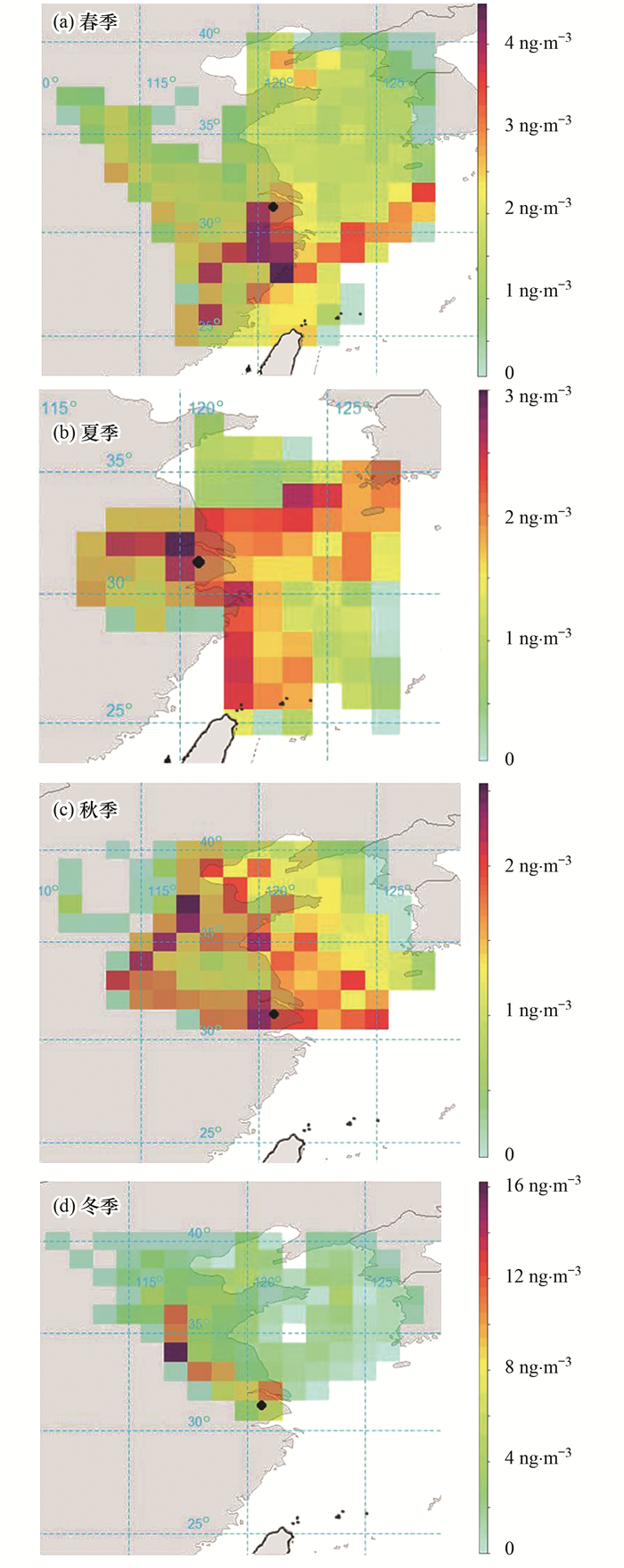
|
图 2 利用CWT模型模拟的不同季节GEM空间分布源 Fig. 2 Spatial contribution of GEM sources simulated by CWT model in different seasons |
如图 3所示, 采用风玫瑰图和汞玫瑰图分析GEM、GOM和PBM对风速和风向的依赖性, 研究监测点附近汞的人为排放源对苏州市汞物种分布的影响.
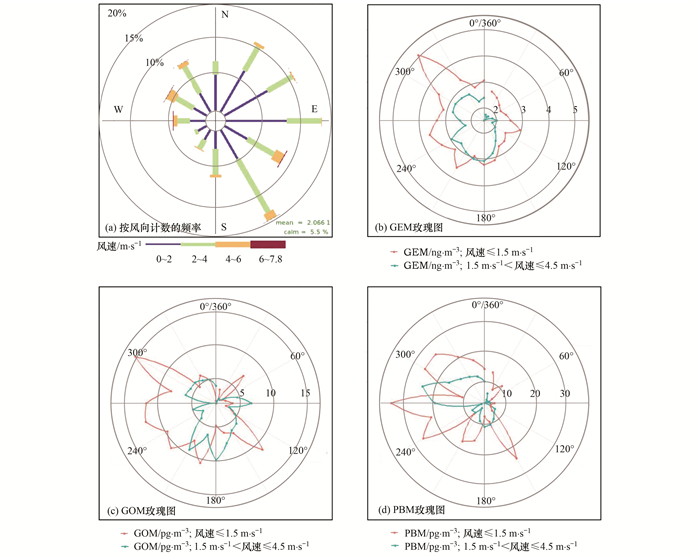
|
图 3 监测期间风玫瑰图和汞玫瑰图 Fig. 3 Wind roses and pollution roses of Hg species during the measurement period |
中国城市地区汞排放源的复杂性普遍较高, 苏州大气汞的人为排放活动主要来自燃煤、钢铁生产、固废焚烧和燃料油的消耗.根据苏州统计年鉴, 2017年苏州市规模以上工业企业分行业能源消耗量统计结果折算, 2017年苏州市因燃煤向大气中排放的汞为2.54 t, 非燃煤向大气中排放的汞为1.72 t.监测点周边30 km范围内的大型点源如图 1所示, 在此区域内汞的点源中以固废焚烧和热电排放源较多, 且主要集中分布在西北方向.
由图 3(a)可见, 苏州地区低风速(≤1.5 m ·s-1)盛行东偏北风(0~135°), 高风速(>1.5 m ·s-1)盛行东风(45°~135°).由图 3(b)分析GEM的风向依赖性, 在低风速时, 在西北方向(270°~360°)上GEM浓度出现了峰值; 在东方向(0~180°)上GEM浓度相对较低, 尤其在高风速时.低风速情况下, GEM浓度与监测点周边汞排放源分布有关, 西北方向上分布着较多的汞排放源(热电厂、固废焚烧厂、钢铁厂等), 使得该方向上GEM浓度出现强烈的峰值; 东向(0~180°)汞排放源相对较分散, 从而该方向上GEM浓度总体较低, 并出现了一个弱峰值.高风速情况下, 东风(0~180°)来自太平洋, 西风(180°~360°)来自内陆, 导致东向GEM浓度总体低于西向(180°~300°)的.
GOM和PBM的风向依赖性显示[图 3(c)和图 3(d)], 在低风速下, 除东北方向(0~90°)外, 其它风向上GOM和PBM均出现了浓度峰值; 在高风速下, 除东北方向(0~90°)外, 其它风向上GOM出现了浓度峰值; 而在高风速下, PBM的峰值仅出现在西偏北方向(270°~300°).由于GOM和PBM在大气中停留时间较短, 在大气中的浓度受当地源影响较大, 因此, 出现所监测到的以上描述的GOM和PBM的风向依赖性现象与监测点周边汞排放源的分布情况密不可分.
2.3 大气汞浓度变化规律 2.3.1 月变化规律如图 4所示, 苏州市大气中GEM、GOM和PBM平均浓度月变化规律.GEM的平均浓度总体变化趋势表现为冬季(1、2月)和春季(4、5月)高于夏季(6~8月)和秋季(9、10月), 这种月变化规律在国内外的监测结果中比较典型.一方面, 燃烧源是大气中GEM的重要来源, 在寒冷月份, 大气中的汞浓度会随着燃煤量的增加而升高[55].同时, 由于气温较冷时大气混合层高度降低, 不利于污染物的扩散, 较暖的季节不仅大气混合层高度增加, 而且干湿沉降幅度较大[56].另一方面, 由以上的CWT分析可以看出, 夏季和秋季部分气团来自海洋, 海洋的空气质量相对较好, 汞浓度相对较低.因此, 常常出现GEM的平均浓度冬季和春季高、夏季和秋季低的现象.然而, 相邻的沿海城市上海的监测结果却不同, 上海的为夏季(6、7月)和初冬(12月)较高, 8、11月较低.此外, 可能由于夏季气温高, 加快海洋和地表释放, 也可能是人为排放导致的, 使得上海和阿尔马登等地出现夏季一些月份GEM较高的现象[9].
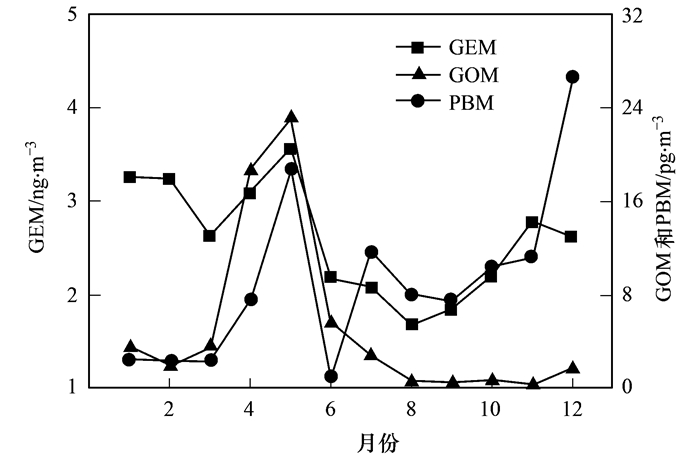
|
图 4 汞平均浓度月变化规律 Fig. 4 Monthly variations of Hg species |
4月和5月苏州市大气中的GOM月平均浓度相对较高, 而其它月份GOM月平均浓度很低, 且相对稳定.从汞的风向玫瑰图可见[图 5(b)], 4月和5月监测点周边各个方向上的GOM浓度都高于其它月份的.由于GOM在大气中停留时间较短, 长距离输送对GOM的影响有限, GOM通常被认为是GEM的光化学氧化和PBM的光还原或光分解形成的, 在夏季GOM的浓度应该更高[8].然而, 这一监测结果对GOM的主要来源的研究不应被忽视, GOM人为排放可能是导致这一规律的主要原因.
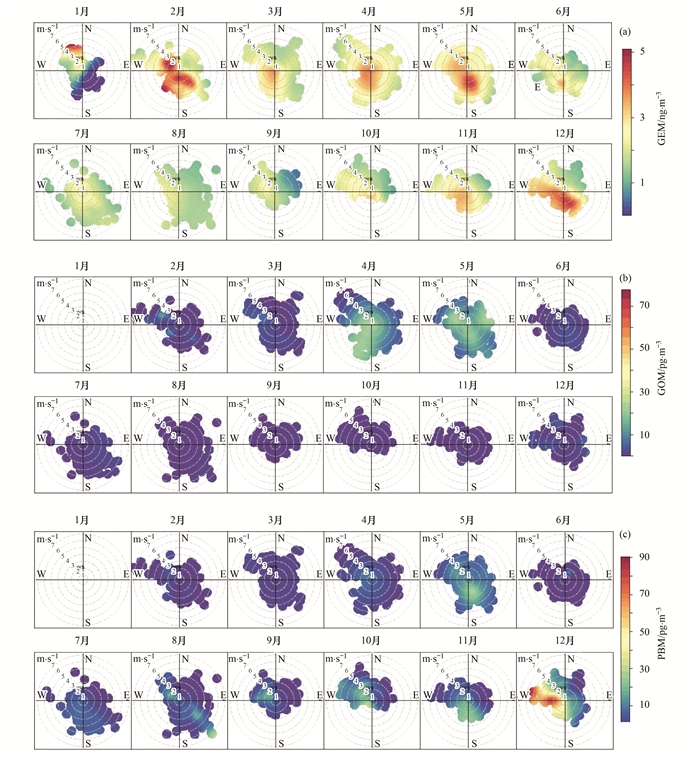
|
图 5 各风向汞浓度的月变化规律 Fig. 5 Monthly variation of mercury concentration in different wind directions |
12月苏州市大气中的PBM平均浓度最高, 其次是5月的, 6月PBM平均浓度断崖式下降到一年中的最低值.从汞的风向玫瑰图可见[图 5(c)], 5月高浓度的PBM主要来自于东南方向; 12月, 高浓度的PBM主要来自于西方向.该变化规律不同于其它城市监测到的规律, 厦门大气的PBM月变化与GEM的相同, 上海大气中PBM的12月的月平均浓度是9月的10倍[8, 9].PBM与GEM的月变化不一致, 说明PBM的来源与GEM的来源存在一定的差异.
2.3.2 日变化规律图 6所示为苏州市大气中3种形态汞(GEM、GOM和PBM)、共同污染物浓度(O3、NOx、CO和SO2)和气象参数(太阳总辐射、湿度和气温)的平均浓度日变化规律. 3种形态汞均表现出明显的日变化, 其中GEM和PBM的变化规律很相似.总体而言, 白天GEM和PBM平均浓度低于夜间的[图 6(a)].这一日变化规律与之前在上海、贵阳、重庆、哥德堡和阿尔马登等城市进行的研究一致[8, 9, 23].
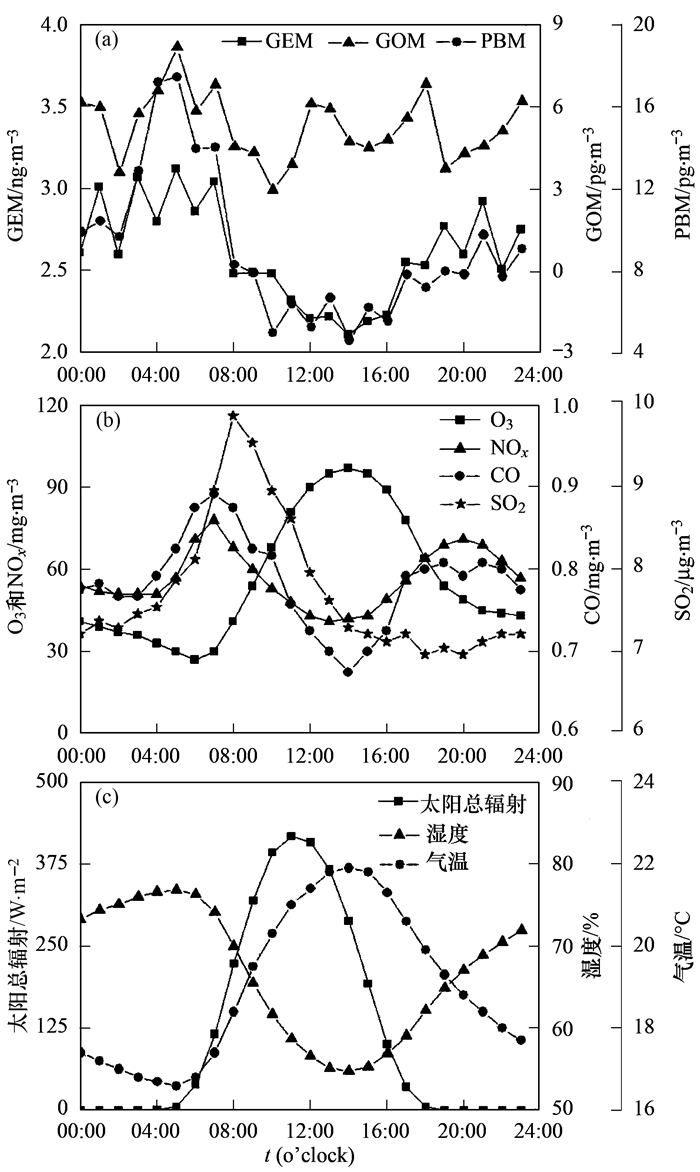
|
图 6 形态汞、共同污染物浓度(O3、NOx、CO和SO2)和气象参数(太阳总辐射、湿度和气温)平均浓度日变化规律 Fig. 6 Diurnal variations of Hg species, selected co-pollutants (O3, NOx, CO, SO2), and meteorological parameters (SR, RH, and T) |
苏州市大气中GEM与太阳总辐射呈极其显著的相关性(r=-0.664, P < 0.001), 与湿度呈极其显著的相关性(r=0.859, P < 0.001), 与气温呈极其显著的相关性(r=-0.866, P < 0.001); PBM与太阳总辐射呈非常显著的中等相关性(r=-0.554, P < 0.01), 与湿度呈极其显著的相关性(r=0.835, P < 0.001), 与气温呈极其显著的相关性(r=-0.831, P < 0.001).因此, 除了人为排放, GEM和PBM与气象参数有很强的相关性, 其日变化规律很大程度上是由气象条件引起的.
GOM平均浓度在1 d内出现多次峰值(出现在05:00、12:00、18:00、23:00)和谷值(出现在02:00、10:00、15:00和19:00), 如图 6(a).上午04:00~08:00和下午16:00~18:00为早晚高峰时间, GOM浓度升高与燃料油燃烧直接排放有关; 12:00~13:00是一天中O3浓度较高的时段, GOM浓度升高与O3氧化GEM生成GOM有关.Sillman等[57]运用输送和光化学模型表明, GEM与GOM之间的强相关性与人为排放和光化学转换有关.因此, 在人为源和GEM氧化转化影响下, 苏州市大气中GOM平均浓度在1 d内出现多次峰值和谷值.
3 结论(1) 2018年苏州市大气中GEM、GOM和PBM年均浓度分别为(2.57±2.09)ng ·m-3、(5.27±15.7)pg ·m-3和(16.0±157)pg ·m-3, 其中, GEM约占总汞的99.2%, 远超GOM(0.2%)和PBM(0.6%).
(2) 苏州市大气中汞迁移具有季节性差异:春季的汞气团主要来自于正南方的内陆, 少量来自于东南方向的东海; 夏季的汞气团来自于本地和东北方向的黄海和东南方向的东海; 秋季的汞气团来自于北方的内陆、黄海和渤海; 冬季的汞气团来自于东北方向的内陆.
(3) 苏州市大气中汞分布特征具有风向依赖性, 在低风速时, 西北方向(270°~360°)上GEM浓度出现了峰值; 在高风速时, 东方向(0~180°)上GEM浓度相对较低.在低风速下, 除东北方向(0~90°)外, 其它风向上GOM和PBM均出现了浓度峰值; 在高风速下, 除东北方向(0~90°)外, 其它风向上GOM出现了浓度峰值; 而在高风速下, PBM的峰值仅出现在西偏北方向(270°~300°).
(4) 2018年苏州市大气中GEM月平均浓度总体变化趋势表现为冬季(1、2月)和春季(4、5月)的GEM高于夏季(6~8月)和秋季(9、10月). 4月和5月苏州市大气中的GOM月平均浓度较高, 而其它月份很低且相对稳定. 12月苏州市大气中的PBM平均浓度最高, 其次是5月, 6月断崖式下降到一年中的最低值.
(5) 苏州市大气中GEM和PBM平均浓度表现为昼间低于夜间的, 与太阳总辐射、湿度和气温呈现正相关, GEM和PBM日变化规律受人为源和气象条件影响.GOM平均浓度在一天内出现多次峰值和谷值, GOM日变化规律是人为源和GEM氧化转化共同引起的.
| [1] | Nguyen L S P, Sheu G R, Lin D W, et al. Temporal changes in atmospheric mercury concentrations at a background mountain site downwind of the East Asia continent in 2006-2016[J]. Science of the Total Environment, 2019, 686: 1049-1056. DOI:10.1016/j.scitotenv.2019.05.425 |
| [2] |
尚帅, 田珮, 蒋煜, 等. 水稻对气态单质汞的吸收与挥发[J]. 环境科学, 2017, 38(12): 5308-5314. Shang S, Tian P, Jiang Y, et al. Uptake and volatilization of gaseous elemental mercury by paddy rice[J]. Environmental Science, 2017, 38(12): 5308-5314. |
| [3] | Zhao L S, Xu L L, Wu X, et al. Characteristics and sources of mercury in precipitation collected at the urban, suburban and rural sites in a city of Southeast China[J]. Atmospheric Research, 2018, 211: 21-29. DOI:10.1016/j.atmosres.2018.04.019 |
| [4] |
杨静, 陈龙, 刘敏, 等. 上海典型燃烧源铅和汞大气排放趋势分析[J]. 环境科学, 2018, 39(9): 3987-3994. Yang J, Chen L, Liu M, et al. Historical trends of atmospheric Pb and Hg emissions from fossil fuel combustion in Shanghai[J]. Environmental Science, 2018, 39(9): 3987-3994. |
| [5] | UNEP. Global mercury assessment 2013: sources, emissions, releases and environmental transport[R]. Geneva, Switzerland: UNEP Chemicals Branch, 2013. 6-11. |
| [6] |
张成, 张雅惠, 王永敏, 等. 重庆市燃煤电厂汞排放特征及排放量[J]. 环境科学, 2017, 38(2): 495-501. Zhang C, Zhang Y H, Wang Y M, et al. Characteristics of mercury emissions from coal-fired power plants in Chongqing[J]. Environmental Science, 2017, 38(2): 495-501. |
| [7] | Zhang L, Wang S X, Wang L, et al. Updated emission inventories for speciated atmospheric mercury from anthropogenic sources in China[J]. Environmental Science & Technology, 2015, 49(5): 3185-3194. |
| [8] | Xu L L, Chen J S, Yang L M, et al. Characteristics and sources of atmospheric mercury speciation in a coastal city, Xiamen, China[J]. Chemosphere, 2015, 119: 530-539. DOI:10.1016/j.chemosphere.2014.07.024 |
| [9] | Duan L, Wang X H, Wang D F, et al. Atmospheric mercury speciation in Shanghai, China[J]. Science of the Total Environment, 2017, 578: 460-468. DOI:10.1016/j.scitotenv.2016.10.209 |
| [10] | Kock H H, Bieber E, Ebinghaus R, et al. Comparison of long-term trends and seasonal variations of atmospheric mercury concentrations at the two European coastal monitoring stations Mace Head, Ireland, and Zingst, Germany[J]. Atmospheric Environment, 2005, 39(39): 7549-7556. DOI:10.1016/j.atmosenv.2005.02.059 |
| [11] | Sprovieri F, Gratz L E, Pirrone N. Development of a ground-based atmospheric monitoring network for the Global Mercury Observation System (GMOS)[A]. In: E3S Web of Conferences. Proceedings of the 16th International Conference on Heavy Metals in the Environment[C]. EDP Sciences, 2013. |
| [12] | Lindberg S, Bullock R, Ebinghaus R, et al. A synthesis of progress and uncertainties in attributing the sources of mercury in deposition[J]. AMBIO:A Journal of the Human Environment, 2007, 36(1): 19-33. DOI:10.1579/0044-7447(2007)36[19:ASOPAU]2.0.CO;2 |
| [13] | Sprovieri F, Pirrone N, Ebinghaus R, et al. Worldwide atmospheric mercury measurements:a review and synthesis of spatial and temporal trends[J]. Atmospheric Chemistry & Physics Discussions, 2010, 10(1): 1261-1307. |
| [14] | Diéguez M C, Bencardino M, Garcia P E, et al. A multi-year record of atmospheric mercury species at a background mountain station in Andean Patagonia (Argentina):temporal trends and meteorological influence[J]. Atmospheric Environment, 2019, 214: 116819. DOI:10.1016/j.atmosenv.2019.116819 |
| [15] | Zhang H, Wang Z W, Wang C J, et al. Concentrations and gas-particle partitioning of atmospheric reactive mercury at an urban site in Beijing, China[J]. Environmental Pollution, 2019, 249: 13-23. DOI:10.1016/j.envpol.2019.02.064 |
| [16] | Sheu G R, Nguyen L S P, Truong M T, et al. Characteristics of atmospheric mercury at a suburban site in northern Taiwan and influence of trans-boundary haze events[J]. Atmospheric Environment, 2019, 214: 116827. DOI:10.1016/j.atmosenv.2019.116827 |
| [17] | Kabashnikov V P, Chaikovsky A P, Kucsera T L, et al. Estimated accuracy of three common trajectory statistical methods[J]. Atmospheric Environment, 2011, 45: 5425-5430. DOI:10.1016/j.atmosenv.2011.07.006 |
| [18] |
刘心东, 刘明, 张若宇, 等. 华东高山背景点大气气态汞含量与传输特征[J]. 中国环境科学, 2019, 39(7): 2758-2764. Liu X D, Liu M, Zhang R Y, et al. Level and transport characteristic of gaseous elemental mercury at a background mountain site of East China[J]. China Environmental Science, 2019, 39(7): 2758-2764. DOI:10.3969/j.issn.1000-6923.2019.07.008 |
| [19] | Zhu J, Wang T, Talbot R, et al. Characteristics of atmospheric Total Gaseous Mercury (TGM) observed in urban Nanjing, China[J]. Atmospheric Chemistry and Physics, 2012, 12(24): 12103-12118. DOI:10.5194/acp-12-12103-2012 |
| [20] | Huang J Y, Liu C K, Huang C S, et al. Atmospheric mercury pollution at an urban site in central Taiwan:mercury emission sources at ground level[J]. Chemosphere, 2012, 87(5): 579-585. DOI:10.1016/j.chemosphere.2012.01.011 |
| [21] | Chen L G, Liu M, Xu Z C, et al. Variation trends and influencing factors of total gaseous mercury in the Pearl River Delta-a highly industrialised region in South China influenced by seasonal monsoons[J]. Atmospheric Environment, 2013, 77: 757-766. DOI:10.1016/j.atmosenv.2013.05.053 |
| [22] | Sheu G R, Lin N H, Lee C T, et al. Distribution of atmospheric mercury in northern Southeast Asia and South China Sea during Dongsha Experiment[J]. Atmospheric Environment, 2013, 78: 174-183. DOI:10.1016/j.atmosenv.2012.07.002 |
| [23] | Fu X W, Feng X B, Qiu G L, et al. Speciated atmospheric mercury and its potential source in Guiyang, China[J]. Atmospheric Environment, 2011, 45(25): 4205-4212. DOI:10.1016/j.atmosenv.2011.05.012 |
| [24] | Friedli H R, Arellano Jr A F, Geng F, et al. Measurements of atmospheric mercury in Shanghai during September 2009[J]. Atmospheric Chemistry and Physics, 2011, 11(8): 3781-3788. DOI:10.5194/acp-11-3781-2011 |
| [25] | Zhang L, Wang S X, Wang L, et al. Atmospheric mercury concentration and chemical speciation at a rural site in Beijing, China:implications of mercury emission sources[J]. Atmospheric Chemistry and Physics, 2013, 13(20): 10505-10516. DOI:10.5194/acp-13-10505-2013 |
| [26] | Li Z, Xia C H, Wang X M, et al. Total gaseous mercury in Pearl River Delta region, China during 2008 winter period[J]. Atmospheric Environment, 2011, 45(5): 834-838. |
| [27] | Fu X W, Feng X, Liang P, et al. Temporal trend and sources of speciated atmospheric mercury at Waliguan GAW station, Northwestern China[J]. Atmospheric Chemistry and Physics, 2012, 12(4): 1951-1964. DOI:10.5194/acp-12-1951-2012 |
| [28] | Ci Z J, Zhang X S, Wang Z W, et al. Atmospheric Gaseous Elemental Mercury (GEM) over a coastal/rural site downwind of East China:temporal variation and long-range transport[J]. Atmospheric Environment, 2011, 45(15): 2480-2487. DOI:10.1016/j.atmosenv.2011.02.043 |
| [29] | Sheu G R, Lin N H, Wang J L, et al. Temporal distribution and potential sources of atmospheric mercury measured at a high-elevation background station in Taiwan[J]. Atmospheric Environment, 2010, 44(20): 2393-2400. DOI:10.1016/j.atmosenv.2010.04.009 |
| [30] | Fu X W, Feng X B, Wang S F, et al. Temporal and spatial distributions of total gaseous mercury concentrations in ambient air in a mountainous area in southwestern China:implications for industrial and domestic mercury emissions in remote areas in China[J]. Science of the Total Environment, 2009, 407(7): 2306-2314. DOI:10.1016/j.scitotenv.2008.11.053 |
| [31] | Wan Q, Feng X B, Lu J L, et al. Atmospheric mercury in Changbai Mountain area, northeastern China Ⅱ. The distribution of reactive gaseous mercury and particulate mercury and mercury deposition fluxes[J]. Environmental Research, 2009, 109(6): 721-727. DOI:10.1016/j.envres.2009.05.006 |
| [32] | Wan Q, Feng X B, Lu J L, et al. Atmospheric mercury in Changbai Mountain area, northeastern China I. The seasonal distribution pattern of total gaseous mercury and its potential sources[J]. Environmental Research, 2009, ·109(3): 201-206. |
| [33] | Choi E M, Kim S H, Holsen T M, et al. Total gaseous concentrations in mercury in Seoul, Korea:local sources compared to long-range transport from China and Japan[J]. Environmental Pollution, 2009, 157(3): 816-822. DOI:10.1016/j.envpol.2008.11.023 |
| [34] | Kim S H, Han Y J, Holsen T M, et al. Characteristics of atmospheric speciated mercury concentrations (TGM, Hg(Ⅱ) and Hg(p)) in Seoul, Korea[J]. Atmospheric Environment, 2009, 43(20): 3267-3274. DOI:10.1016/j.atmosenv.2009.02.038 |
| [35] | Nguyen H T, Kim M Y, Kim K H. The influence of long-range transport on atmospheric mercury on Jeju Island, Korea[J]. Science of the Total Environment, 2010, 408(6): 1295-1307. DOI:10.1016/j.scitotenv.2009.10.029 |
| [36] | Kono Y, Tomiyasu T. Variations in atmospheric mercury concentration in Kagoshima city during 2010-2012[J]. Bunseki Kagaku, 2014, 63(1): 17-21. DOI:10.2116/bunsekikagaku.63.17 |
| [37] | Osawa T, Ueno T, Fu F F. Sequential variation of atmospheric mercury in Tokai-mura, seaside area of eastern central Japan[J]. Journal of Geophysical Research:Atmospheres, 2007, 112(D19): D19107. DOI:10.1029/2007JD008538 |
| [38] | Chand D, Jaffe D, Prestbo E, et al. Reactive and particulate mercury in the Asian marine boundary layer[J]. Atmospheric Environment, 2008, 42(34): 7988-7996. DOI:10.1016/j.atmosenv.2008.06.048 |
| [39] | Gibi Dč ar D, Horvat M, Logar M, et al. Human exposure to mercury in the vicinity of chlor-alkali plant[J]. Environmental Research, 2009, 109(4): 355-367. |
| [40] | Pyta H, Rosik-Dulewska C, Czaplicka M. Speciation of ambient mercury in the Upper Silesia Region, Poland[J]. Water, Air, and Soil Pollution, 2009, 197: 233-240. DOI:10.1007/s11270-008-9806-9 |
| [41] | Witt M L I, Meheran N, Mather T A, et al. Aerosol trace metals, particle morphology and total gaseous mercury in the atmosphere of Oxford, UK[J]. Atmospheric Environment, 2010, 44(12): 1524-1538. DOI:10.1016/j.atmosenv.2010.01.008 |
| [42] | Brooks S, Moore C, Lew D, et al. Temperature and sunlight controls of mercury oxidation and deposition atop the Greenland ice sheet[J]. Atmospheric Chemistry and Physics, 2011, 11(16): 8295-8306. DOI:10.5194/acp-11-8295-2011 |
| [43] | Lan X, Talbot R, Castro M, et al. Seasonal and diurnal variations of atmospheric mercury across the US determined from AMNet monitoring data[J]. Atmospheric Chemistry and Physics, 2012, 12(21): 10569-10582. DOI:10.5194/acp-12-10569-2012 |
| [44] | Choi H D, Huang J Y, Mondal S, et al. Variation in concentrations of three mercury (Hg) forms at a rural and a suburban site in New York State[J]. Science of the Total Environment, 2013, 448: 96-106. DOI:10.1016/j.scitotenv.2012.08.052 |
| [45] | Lyman S N, Gustin M S. Determinants of atmospheric mercury concentrations in Reno, Nevada, U.S.A.[J]. Science of the Total Environment, 2009, 408(2): 431-438. DOI:10.1016/j.scitotenv.2009.09.045 |
| [46] | Faïn X, Obrist D, Hallar A G, et al. High levels of reactive gaseous mercury observed at a high elevation research laboratory in the Rocky Mountain[J]. Atmospheric Chemistry and Physics, 2009, 9(20): 8049-8060. DOI:10.5194/acp-9-8049-2009 |
| [47] | Nair U S, Wu Y L, Walters J, et al. Diurnal and seasonal variation of mercury species at coastal-suburban, urban, and rural sites in the southeastern United States[J]. Atmospheric Environment, 2012, 47: 499-508. DOI:10.1016/j.atmosenv.2011.09.056 |
| [48] | Gratz L E, Keeler G J, Marsik F J, et al. Atmospheric transport of speciated mercury across southern Lake Michigan:influence from emission sources in the Chicago/Gary urban area[J]. Science of the Total Environment, 2013, 448: 84-95. DOI:10.1016/j.scitotenv.2012.08.076 |
| [49] | Brooks S, Luke W, Cohen M, et al. Mercury species measured atop the Moody Tower TRAMP site, Houston, Texas[J]. Atmospheric Environment, 2010, 44(33): 4045-4055. DOI:10.1016/j.atmosenv.2009.02.009 |
| [50] | Rutter A P, Snyder D C, Stone E A, et al. In situ measurements of speciated atmospheric mercury and the identification of source regions in the Mexico City Metropolitan Area[J]. Atmospheric Chemistry and Physics, 2009, 9(1): 207-220. DOI:10.5194/acp-9-207-2009 |
| [51] | Cheng I, Zhang L, Blanchard P, et al. Concentration-weighted trajectory approach to identifying potential sources of speciated atmospheric mercury at an urban coastal site in Nova Scotia, Canada[J]. Atmospheric Chemistry and Physics, 2013, 13(12): 6031-6048. DOI:10.5194/acp-13-6031-2013 |
| [52] | Baya A P, Van Heyst B. Assessing the trends and effects of environmental parameters on the behaviour of mercury in the lower atmosphere over cropped land over four seasons[J]. Atmospheric Chemistry and Physics, 2010, 10(17): 8617-8628. DOI:10.5194/acp-10-8617-2010 |
| [53] | Song X J, Cheng I, Lu J L. Annual atmospheric mercury species in Downtown Toronto, Canada[J]. Journal of Environmental Monitoring, 2009, 11(3): 660-669. DOI:10.1039/b815435j |
| [54] | Fu X W, Feng X B, Zhang G, et al. Mercury in the marine boundary layer and seawater of the South China Sea:concentrations, sea/air flux, and implication for land outflow[J]. Journal of Geophysical Research:Atmospheres, 2010, 115(D6): D06303. DOI:10.1029/2009JD012958 |
| [55] | Zhang F W, Xu L L, Chen J S, et al. Chemical compositions and extinction coefficients of PM2.5 in peri-urban of Xiamen, China, during June 2009-May 2010[J]. Atmospheric Research, 2012, 106: 150-158. DOI:10.1016/j.atmosres.2011.12.005 |
| [56] | Blanchard P, Froude F A, Martin J B, et al. Four years of continuous Total Gaseous Mercury (TGM) measurements at sites in Ontario, Canada[J]. Atmospheric Environment, 2002, 36(23): 3735-3743. DOI:10.1016/S1352-2310(02)00344-8 |
| [57] | Sillman S, Marsik F J, Al-Wali K I, et al. Reactive mercury in the troposphere:model formation and results for Florida, the northeastern United States, and the Atlantic Ocean[J]. Journal of Geophysical Research:Atmospheres, 2007, 112(D23): D23305. DOI:10.1029/2006JD008227 |
 2020, Vol. 41
2020, Vol. 41


